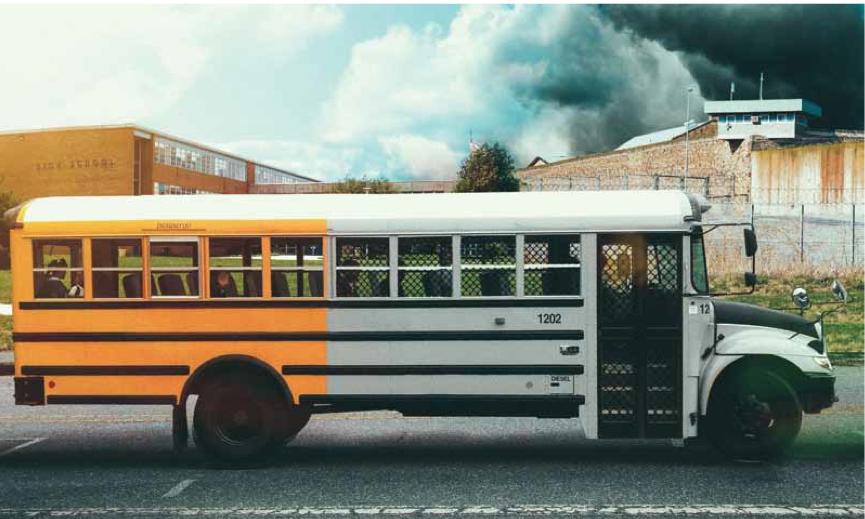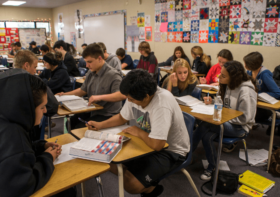From Libraries to Lockups: Houston ISD and the Expansion of the School-to-Prison Pipeline

In 2023, the Houston Independent School District made a decision that sent a clear message to its most vulnerable students: education is no longer the priority—control is. Under the leadership of state-appointed superintendent Mike Miles, dozens of school libraries, primarily in low-income Black and Latino neighborhoods, were shut down and converted into “team centers”—rooms where students can be removed from class and placed on virtual detention. This is not innovation. It is a continuation of the school-to-prison pipeline, repackaged and rebranded.
What’s Happening in Houston
After the Texas Education Agency seized control of Houston ISD, replacing elected officials with state appointees, the new regime immediately slashed librarian positions in 28 schools. The targeted schools serve predominantly low-income communities of color. Their libraries are being replaced with spaces for disciplinary isolation. Other schools—typically in wealthier, whiter areas—continue to benefit from full library services.
Mike Miles defended the move as a “back to basics” strategy focused on funding teachers. In reality, it’s a policy of targeted disinvestment. Children in Houston’s poorest neighborhoods are being told they don’t need books. They need surveillance.
A Historical Pattern of Criminalizing Students
The school-to-prison pipeline didn’t begin with Houston. It emerged in the 1990s through a coordinated expansion of carceral logic into public schools. Following the Gun-Free Schools Act of 1994, zero-tolerance policies were adopted nationwide. These laws punished not only weapons possession but also minor infractions like dress code violations, tardiness, or disrespect. Students began facing suspensions and expulsions for behavior that once would have been handled with counseling or a call home.
Simultaneously, schools installed metal detectors, surveillance systems, and police officers. “Safety” became the justification for creating school environments that mirrored juvenile detention centers. This punitive turn aligned with the broader climate of mass incarceration, broken windows policing, and the militarization of public institutions.
What the Pipeline Looks Like in Practice
The school-to-prison pipeline operates through a series of policy choices that criminalize students rather than support them:
- School-based arrests for behavioral issues
- Suspensions and expulsions without restorative options
- Lack of counselors, therapists, and trauma-informed services
- Failure to accommodate disabilities or address unmet needs
- Disproportionate punishment of students based on race, ability, gender identity, or class
These policies manufacture vulnerability. A single suspension can double the risk of dropping out. Students who are pushed out once are more likely to enter the criminal legal system. Those with juvenile records face barriers to college, employment, and housing. These effects are compounded by race and poverty.

Who Is Most Harmed
The data is clear: the school-to-prison pipeline does not impact all students equally.
- Black students are nearly four times more likely to be suspended than white peers.
- Students with disabilities represent about 13 percent of enrollment but over 25 percent of arrests.
- LGBTQ students face increased surveillance and harsher discipline.
Houston’s decision to eliminate libraries in schools that already face systemic neglect only deepens these disparities. Students in higher-income, majority-white neighborhoods continue to benefit from educational enrichment. Others are given isolation rooms and stripped of opportunity.
The Long-Term Costs
Removing students from classrooms and funneling them into disciplinary spaces produces measurable harm:
- Lower academic achievement
- Increased dropout rates
- Greater exposure to police and courts
- Worsening mental health
- Decreased lifetime earning potential
- Higher risk of future incarceration
These outcomes are the predictable results of policies that treat struggling students as threats instead of children in need of care.
Real Alternatives Exist
There are proven models for addressing conflict in schools without feeding the carceral system. Restorative justice programs create space for accountability through dialogue, not punishment. Trauma-informed practices recognize that behavioral challenges often stem from unmet needs. Schools that reduce police presence and increase access to mental health professionals report better academic outcomes and fewer disciplinary incidents.
Reform is not a matter of theory. It is a matter of political will.
What Needs to Change
Houston’s decision to convert libraries into detention centers reflects a broader institutional failure. Public education should be a place of possibility. For many students, it has become a place of punishment.
We need to demand:
- The reinstatement of librarians and libraries in every school
- The elimination of punitive disciplinary spaces masquerading as “team centers”
- Transparent audits of racial disparities in discipline and resource allocation
- Investment in restorative justice programs and trauma-informed staff training
- The removal of police from school buildings and a reallocation of funds toward student support services
This is not a budget issue. It is a matter of values. What we choose to fund reflects what we choose to believe about our children.
Your Voice Matters
The school-to-prison pipeline does not exist without consent. It is maintained through silence, normalization, and the slow erosion of outrage. Houston’s families, educators, and students deserve more. We all do.
Talk to your school board. Organize in your neighborhood. Support youth-led campaigns. Refuse to accept punishment in place of education.
If we want a different future, we have to fight for it now.



